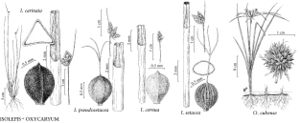Isolepis carinata
Ann. Lyceum Nat. Hist. New York 3: 349. 1836.
Plants annual; rhizomes absent. Culms 1–25 cm × 0.2–0.3 mm. Leaves: sheaths green to stramineous or brown; distal blade mostly much longer than sheath, to 5 cm × 0.2–0.5 mm. Inflorescences: involucral bract 1, 5–25(–33) mm. Spikelets 1–10 × 1.5–2 mm; scales stramineous to pale orangish, midrib region often greenish, markedly gibbous, prominently to obscurely veined, midrib keeled, finely reticulate at 20X, membranous, hyaline, apex rounded, awned; proximal scale to 2.5(–5) mm, awn to 2 mm; other scales 1.8–2 × 1–1.2 mm, awn 0.2–0.5 mm. Flowers: anthers 0.2 mm; styles 3-fid. Achenes often falling with and clasped by floral scales, dark orange-brown or often whitish, broadly ellipsoid to obovoid or outline subcircular, nearly equilaterally trigonous, faces concave, 1–1.5 × 0.7–1 mm, papillose at 10–15X, papillae in many vertical rows, often obscured by thin, minutely reticulate, whitish surface layer.
Phenology: Fruiting spring.
Habitat: Wet, often drying, freshwater places in grasslands, rock barrens, open woods, lawns, cultivated fields, waste places
Elevation: 0–800 m
Distribution

Ala., Ark., Calif., Fla., Ga., Ill., Kans., Ky., La., Miss., Mo., N.C., Okla., S.C., Tenn., Tex.
Discussion
Isolepis carinata sometimes occurs in mixed populations with the very similar I. pseudosetacea.
Selected References
None.
